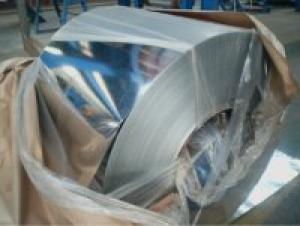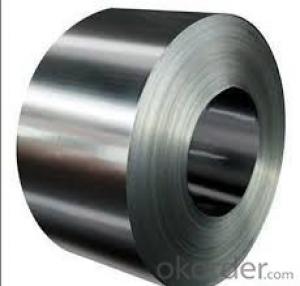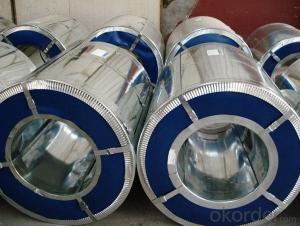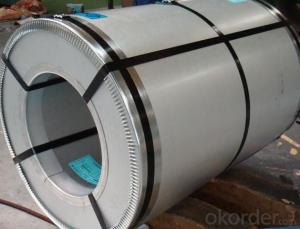PPGI Prepainted Galvanized Steel Coil/Roofing Steel
- Loading Port:
- Shanghai
- Payment Terms:
- TT OR LC
- Min Order Qty:
- 50 m.t.
- Supply Capability:
- 8000 m.t./month
OKorder Service Pledge
OKorder Financial Service
You Might Also Like
PPGI Prepainted Galvanized Steel Coil/Roofing Steel :
| Standard: | AISI,ASTM,BS,DIN,GB,JIS | Grade: | SGCC | Thickness: | 0.18mm-1.2mm |
| Place of Origin: | China (Mainland) | Brand Name: | CNBM | Type: | Steel Coil |
| Technique: | Hot Rolled | Surface Treatment: | Galvanized | Application: | building material |
| Special Use: | High-strength Steel Plate | Width: | 914mm-1250mm | Length: | as per customer |
| color: | ral k7 |
Packaging & Delivery
| Packaging Detail: | seaworthy export package 3 eye bands and 3 circumferential bands in steel, galvanized metal fluted rings on inner and outer edges, galvanized metal & waterproof paper wall protection disk, galvanized metal & waterproof paper around circumference. |
| Delivery Detail: | 15 Days after advance payment |
Name | PPGI |
Raw material | SGCC |
Thickness | 0.18mm-1.2mm |
Width | 914mm-1250mm |
Tolerance | Thickness+/-0.01mm |
Surface treatment | Galvanized |
T bending (top-coating) T bending (back-coating) | 3T 4T |
Anti-MEK wiping | ≥100times |
Zinc coating | 40-100g |
Painting thickness: top back | 15-16u 6-7u |
Type of coating structure | 2/1 |
standard | ASTM,GB,JIS |
Coil weight | 3ton-5ton |
Coil ID | 508 |
Color | RAL (customized) |
Applications | Building industry, structural use, roofing, commercial use, household appliance, industry facilities |
Attentions in transportation and storage :
1:PPGI should be stored in neat and tidy environment to avoid possible corrosion caused by all kinds of corrasive medium.
2:The ground for storage should be flat, without hard object, and with sufficient loading-bearing capacity.
3:Storage environment should be dry and ventilated. Avoiding storing outdoors or with dew or with wide temp difference.
4:Coil could not be dragged lest the burr caused by slicing will scratch the coil surface underneath. Coil should be handled with care, without hitting any hard objects.
- Q:What website can I use to find a good picture that shows the atomic structure of a carbon steel?
- Carbon steel is a polycrystalline substance containing several compounds. Most of it is iron, but there are crystals of austenite and martensite present, plus other iron carbides. Each of these has a different atomic structure. The properties of the steel depend not so much on the atomic structures of the compounds, but more on the size and abundance of the crystals. The function of these crystals is to impede the movements of dislocations through the iron.
- Q:How are steel coils used in the manufacturing of shipbuilding?
- Steel coils are used in shipbuilding for several purposes. They are primarily used to fabricate the hull and structural components of ships. Steel coils are cut, shaped, and welded to form various ship sections, such as the hull plates, bulkheads, and decks. These coils provide the necessary strength, durability, and corrosion resistance required for marine applications. Additionally, steel coils are also used to manufacture other shipbuilding components like piping, machinery, and equipment, ensuring the overall integrity and functionality of the vessel.
- Q:What are the different types of steel coil packaging?
- There are several types of steel coil packaging, including steel strapping, stretch wrapping, shrink wrapping, and wooden crates.
- Q:What are the different steel coil specifications?
- There are various steel coil specifications available, including dimensions (thickness, width, and length), chemical composition, mechanical properties (such as tensile strength and yield strength), surface finish, and coating options. These specifications vary depending on the specific application and industry requirements.
- Q:Myself, iam Working In a Steel Fabrication Company. I completed my Engineering in 2006 and immediately recruited in this company in Oman. My company is Steel Fabrication company .So as i am new to this field, i just need some basic knowledge regarding this Steel Fabrication.Waiting for ur early reply.
- Your question covers a VERY broad area. This link should help you out, you will still have numerous other places you can look but this will cover your basics.
- Q:I need to know how you rate the hardness of steel any ideas?
- There's an instrument called a hardness tester. It has a stylus which is pressed into the surface of a sample of steel with a calibrated amount of force. The distance it penetrates tells you how hard the steel is. (This is sometimes called 'indentation hardness'). The most common scale is the Rockwell Scale. Actually it gets a little complicated because there are several scales, one for tungsten carbide (the hardest man-made material), one for aluminum and brass and soft steels, and one for hardened steels. Another scale for indentation hardness is the Brinell scale. It's a little less complicated, with one scale to measure the hardness of wood, plastic, etc. as well as steel.
- Q:What are the common coil thicknesses available for steel coils?
- The common coil thicknesses available for steel coils range from 0.15mm to 25mm, depending on the specific requirements and applications.
- Q:What are the challenges in coil slitting for thin gauge materials?
- Successfully operating coil slitting for thin gauge materials involves addressing a specific set of challenges. One major challenge is ensuring the proper handling and stability of the thin gauge material. The material's susceptibility to deformation, wrinkling, or tearing increases as it becomes thinner. To tackle this, careful attention must be given to the handling equipment and techniques used during the slitting process. This is necessary to maintain the appropriate tension and support throughout the operation. Another challenge is maintaining consistent and precise slitting widths. Thin gauge materials are often used in applications where accuracy is crucial, such as electronic components or automotive parts. Any variation in the slitting width can cause functional defects or assembly problems. Achieving precise slitting widths in thin gauge materials requires the use of high-quality slitting knives, well-maintained slitting machinery, and accurate tension control systems. In addition, thin gauge materials are more prone to surface defects, such as scratches or burrs, during the slitting process. These defects can impact the material's appearance, performance, or even its safety. To minimize the occurrence of surface defects, it is important to carefully select slitting knives and regularly maintain the slitting machinery. Furthermore, thin gauge materials often possess a higher yield strength, making them more resistant to deformation. This poses a challenge when it comes to achieving clean and straight edges during the slitting process. Special considerations must be taken to ensure that the slitting knives are sharp and properly aligned, allowing for clean cuts without introducing any edge defects. Lastly, thin gauge materials are generally more sensitive to external factors such as temperature, humidity, or static electricity. These factors can affect the material's dimensional stability, resulting in variations in slitting width or other quality issues. Therefore, it is crucial to establish appropriate environmental conditions and implement effective anti-static measures to minimize the impact of these factors. To summarize, the challenges associated with coil slitting for thin gauge materials revolve around handling and stability, maintaining precise slitting widths, minimizing surface defects, achieving clean and straight edges, and mitigating the influence of external factors. Overcoming these challenges requires a combination of suitable equipment, techniques, and operational controls to ensure high-quality slitting outcomes.
- Q:How are steel coils used in the production of fireproof doors?
- Steel coils are used in the production of fireproof doors as they are the primary material for constructing the door's core. The steel coils are shaped and layered to create a strong and heat-resistant core, which provides the necessary structural integrity and fire resistance required for fireproof doors.
- Q:What are the different types of steel coil cutting methods?
- There are several different types of steel coil cutting methods, including slitting, shearing, and laser cutting. Slitting involves cutting the coil into narrower strips using rotating circular knives. Shearing is the process of cutting the coil using straight blades to create straight edges. Laser cutting uses a focused laser beam to melt and vaporize the steel, resulting in a precise and clean cut.
1. Manufacturer Overview |
|
|---|---|
| Location | |
| Year Established | |
| Annual Output Value | |
| Main Markets | |
| Company Certifications | |
2. Manufacturer Certificates |
|
|---|---|
| a) Certification Name | |
| Range | |
| Reference | |
| Validity Period | |
3. Manufacturer Capability |
|
|---|---|
| a)Trade Capacity | |
| Nearest Port | |
| Export Percentage | |
| No.of Employees in Trade Department | |
| Language Spoken: | |
| b)Factory Information | |
| Factory Size: | |
| No. of Production Lines | |
| Contract Manufacturing | |
| Product Price Range | |
Send your message to us
PPGI Prepainted Galvanized Steel Coil/Roofing Steel
- Loading Port:
- Shanghai
- Payment Terms:
- TT OR LC
- Min Order Qty:
- 50 m.t.
- Supply Capability:
- 8000 m.t./month
OKorder Service Pledge
OKorder Financial Service
Similar products
New products
Hot products
Hot Searches
Related keywords




























